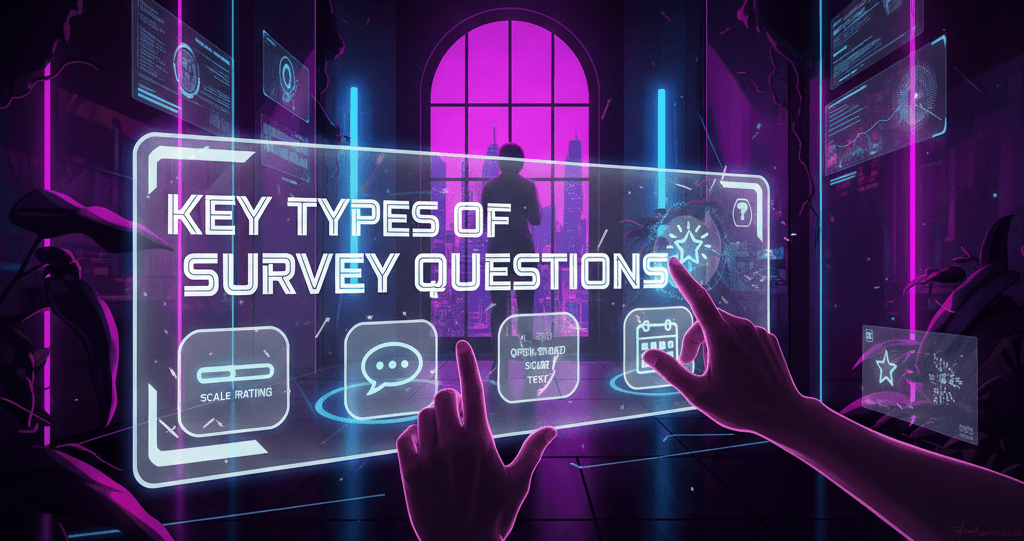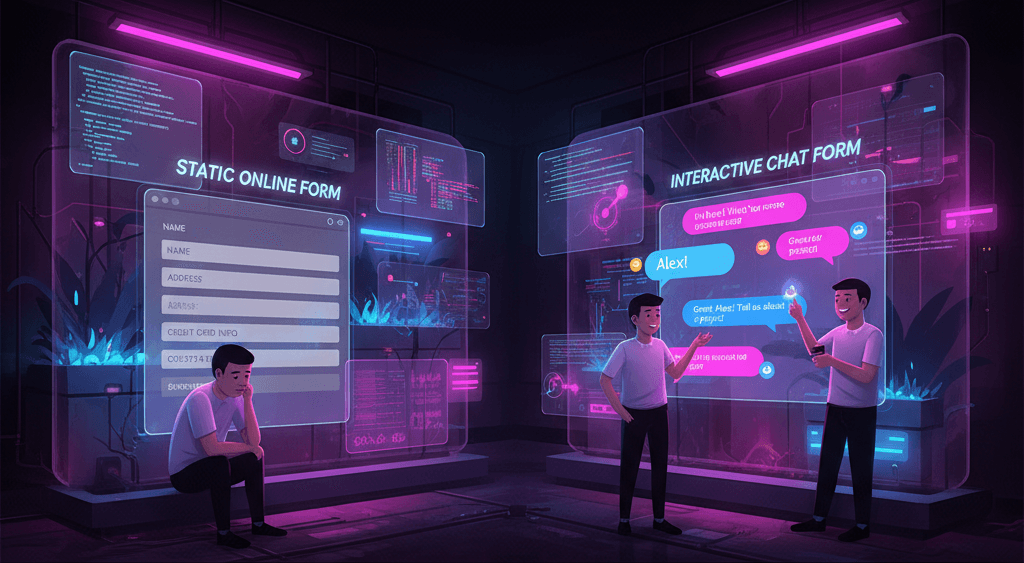Do you need to make a survey but don’t know what to ask? You’re not alone. Making a good survey can be tricky. You need answers that are truly useful. The key is to pick the right types of questions.
Think of it like cooking. You wouldn’t use a whisk to chop vegetables. In the same way, a “yes/no” question doesn’t work when you want to understand deep customer feelings. Using the right tool for the job is key.
In this guide, we will show you the main types of survey questions. We will share examples and explain when to use each one. Let’s turn that blank page into a great survey.
So, You Need to Make a Survey? Let’s Talk Questions.
You have a goal. Maybe you want to check customer happiness or test a new product. Or maybe you just want to know your audience better. Your survey connects your questions to their answers. But if your questions are confusing or unclear, you won’t get the good data you need.
To make a good survey, you need to know the different types of questions you can use. This is a very real step you can take. It will help you get clear answers you can act on.
Why Bother With Different Question Types Anyway?
It’s a good question. Why not just use text boxes and let people type what they want? That can work sometimes. But mixing up your question types is very important for a few big reasons:
- Better Data: A multiple-choice question gives you clean data for charts. An open-ended question gives you detailed stories. Using the right type helps you get the answers you really need.
- An Easier Survey: Let’s be honest, no one likes long, boring surveys. A mix of clicking, rating, and typing keeps it interesting. This stops people from getting tired of the survey. A happy person is more likely to finish and give good answers.
- Easier to Understand Results: When you get your answers, some questions are easy to review. Things like rating scales or dropdowns help you see patterns quickly. This makes your job much easier.
In the end, a good mix of questions makes for a better survey. It also gives you data you can trust to make decisions.
The Bread and Butter: Closed-Ended Questions
Closed-ended questions are very common and useful. They give people a set list of answers to pick from. They are quick to answer and easy for you to study. They are great for getting numbers, like “what” and “how many.”
Multiple-Choice: The Classic All-Rounder
You have seen these many times. Multiple choice questions give a list of options. They ask the person to pick only one. They are very useful for all kinds of surveys.
When to use them:
- When the answers are clear and different from each other.
- For asking what people like, what they know, or about simple facts.
- When you need to sort your data into groups (e.g., “What is your main job?”).
Survey questions examples:
How did you first hear about us?
- ( ) Social Media
- ( ) A Friend or Colleague
- ( ) Google Search
- ( ) Advertisement
Which of our pricing plans are you currently on?
- ( ) Free Plan
- ( ) Basic Plan
- ( ) Pro Plan
Pro Tip: Always add an “Other (please explain)” option. You can’t guess every possible answer. This small option can lead to surprising new ideas. In ZINQ Forms, you can add a text box to your “Other” option with one click. This helps you get all the useful and unexpected feedback.
Checkboxes: When One Answer Isn’t Enough
These are like multiple-choice questions, but with one big difference. People can pick all the answers that fit. Use this when one answer is not enough to tell the whole story.
When to use them:
- When you want to know all the products or features a person uses.
- To learn what people are interested in when many choices are possible.
Survey questions examples:
Which of the following features do you use at least once a week? (Select all that apply)
- [ ] Dashboard Analytics
- [ ] Automated Reporting
- [ ] Team Collaboration Tools
- [ ] Mobile App
What topics would you like to see on our blog? (Select all that apply)
- [ ] Industry News
- [ ] Product Tutorials
- [ ] Customer Case Studies
- [ ] Leadership Advice
Rating Scales (Likert, Stars, etc.): Measuring Feelings and Opinions
How do you measure something personal, like how happy someone is? With rating scale questions! These ask people to rate their feelings on a scale. This gives you a simple way to turn opinions into numbers.
The most famous type is the Likert scale. It gives a statement and asks people how much they agree or disagree.
Likert scale questions examples:
“The checkout process was easy.”
- ( ) Strongly Disagree ( ) Disagree ( ) Neutral ( ) Agree ( ) Strongly Agree
How satisfied are you with our customer support?
- ( ) Very Unsatisfied ( ) Unsatisfied ( ) Neutral ( ) Satisfied ( ) Very Satisfied
Other common scales use stars (1 to 5) or numbers (like 0 to 10). A popular question is, “How likely are you to recommend us?” These are great for customer feedback. They quickly show you how people feel.
ZINQ Forms Fun Fact: We have found that scales with pictures get more answers. That’s why our online survey tool has fun options like emoji scales and sliders. A smiley face scale can feel more friendly and human than a list of dots.
Dropdown Menus: For a Long List of Clean Answers
Do you have a long list of options? A dropdown menu can help. It keeps your survey from looking messy with too many choices. A dropdown hides the list until you click it.
When to use them:
- For long lists that do not change, like countries, states, or years.
- When you want to keep your survey looking clean and short.
Survey questions examples:
What country do you live in?
[Select from dropdown]What year were you born?
[Select from dropdown]
Getting the Full Story: Open-Ended Questions
Sometimes, you need more than a number or a set choice. You need the story and the “why” behind an answer. That’s where open-ended questions help. They give people a text box to type their own answers.
The ‘Text Box’: When You Need the Full Story
This question type lets you hear what users are really thinking. A simple text box asks for feedback in their own words. This can be very useful. You can use a small box for short answers. Or you can use a larger box for more detailed thoughts.
Survey questions examples:
- Is there anything we could do to improve your experience?
- What was the main reason you decided to sign up today?
- Do you have any other comments, questions, or concerns?
When to Use Them (and When to Avoid Them)
Open-ended questions are great, but use them with care. They take more work for the person to answer. They also take more work for you to review.
Use them when:
- You are exploring a new topic and don’t know all the possible answers yet.
- You want to get quotes, reviews, or personal stories.
- You want to give people a space to share good or bad feedback at the end.
Avoid them when:
- You need data that is easy to put into a chart or count.
- Your survey is already long. These questions can make people quit.
- You do not have time to read and study hundreds of text answers.
Here’s a great tip: The hardest part of these questions is studying the answers. This is where new tools can help. For example, ZINQ AI can study thousands of text answers in seconds. It finds common topics and sees if the feedback is good or bad. It gives you a short report of what people are saying. This turns a lot of text into useful information, saving you a lot of work.
A Few More Handy Question Types You Should Know
Beyond the basics, a few other question types can really improve your data.
Demographic Questions: Getting to Know Your Audience
Demographic survey questions ask about things like age, gender, location, income, or school level. This information is very valuable. It helps you sort your survey answers into groups.
Imagine you learn that your happiest customers are all in one age group. Or that users in one industry have trouble with a certain feature. That is the power of these questions.
Survey design best practices for demographics:
- Ask at the end: People are more willing to answer personal questions after they have started the survey.
- Make them optional: Never force someone to answer.
- Use ranges: For private topics like income, give people ranges to choose from. Do not ask for an exact number.
Ranking Questions: What’s Most Important?
A ranking question asks people to put a list of items in order. They rank them from most liked to least liked. This is perfect when you need to know what is most important to them.
When to use them:
- To decide which new product features to build first.
- To learn which parts of your service customers like the most.
Survey questions examples:
Please rank the following features in order of importance to you (1 = most important).
- __ 24/7 Customer Support
- __ Mobile App Access
- __ Advanced Analytics
- __ Integrations with other tools
Oops! Common Survey Question Blunders to Dodge
Knowing how to write survey questions also means knowing what to avoid. Steer clear of these common mistakes. This will keep your data good and your survey takers happy.
Avoiding the Dreaded Double-Barreled Question
This is a tricky question that asks about two different things at once.
- Example: “How happy are you with the speed and performance of our website?”
What if the site is fast but often breaks? Or what if it works well but is slow? The person cannot give a clear answer.
- The fix: Ask two different questions instead.
- “How happy are you with the speed of our website?”
- “How happy are you with the performance of our website?”
Keeping It Simple: Why You Shouldn’t Use Jargon
Do not think your audience knows your company’s special terms or acronyms. Using hard words is the fastest way to confuse people. This leads to wrong answers.
- Example: “Did our new CRM integration sufficiently optimize your B2B lead-gen funnel?”
- The fix: “Did our new customer data tool help you find more potential clients?”
Write clearly. Your goal is to be understood, not to sound smart. A good rule is to write questions that a 10-year-old can understand.
Putting It All Together (Without the Headache)
That was a lot of information! But do not worry. You do not need to be an expert to build a great survey. You just need a clear goal and the right tools.
Quick Recap: Matching the Question to Your Goal
Here’s a simple cheat sheet for when to use different question types:
- To get clean data with numbers: Use closed-ended questions. These include multiple-choice, checkboxes, and rating scales.
- To understand the “why” and get detailed stories: Use open-ended text box questions.
- To put a list of items in order of importance: Use a ranking question.
- To sort your results into groups: Use demographic questions (at the end!).
Ready to Build? Making It Easy with ZINQ Forms
It is good to know about all the different form builder questions. But building a survey that looks good and works well is the next step. That’s where a great online survey tool can help.
With ZINQ Forms, we made it very easy to build your survey. You can drag and drop all the question types we talked about today. Our simple design helps you make a great survey without having to think too hard about the rules.
Plus, with ZINQ AI, you can do more than just collect data. You can start to understand it right away. Let our AI suggest good questions for your survey. You can also have it review your open-ended answers to find the most important ideas.
Are you ready to make surveys that people enjoy taking?
Try ZINQ Forms today and see how easy it is to connect with your customers.












